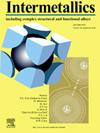Corrosion behavior of aged NiTi shape memory alloys
IF 4.3
2区 材料科学
Q2 CHEMISTRY, PHYSICAL
引用次数: 0
Abstract
The corrosion behavior of 55.89 wt% Ni-NiTi Shape Memory Alloy (SMA) when aged at two aging temperatures, namely 450 °C and 650 °C is deeply investigated. To this end, Open Circuit Potential (OCP) tests, linear and cyclic potentiodynamic polarizations as well as Electrochemical Impedance Spectroscopy (EIS) were performed in physiological solution 0.9 % NaCl.
The OCP measurements suggest that the aging temperature significantly affects the formation and stability of the passive oxide film on the NiTi surface. Potentiodynamic polarization results show that 450 °C aged NiTi exhibits the best corrosion resistance. Compared to the as-received NiTi alloy, the corrosion current density (jcorr) of the 450 °C aged NiTi decreases by around 87 %, while the 650 °C aged NiTi shows lower corrosion resistance, with jcorr decreasing by 21 %.
The lowest passive current density (ip) for the 450 °C aged sample confirms its superior corrosion resistance compared to the other conditions. The higher impedance magnitude (Z′) for the 450 °C aged sample indicates a more protective passive layer. Cyclic voltammetry collectively demonstrates that aging at 450 °C significantly enhances the corrosion resistance of NiTi in a physiological environment. This improvement is primarily due to microstructural changes, including grain refinement and the formation of Ti3Ni4 precipitates, which contribute to the formation of a more protective passive film.
求助全文
约1分钟内获得全文
求助全文
来源期刊

Intermetallics
工程技术-材料科学:综合
CiteScore
7.80
自引率
9.10%
发文量
291
审稿时长
37 days
期刊介绍:
This journal is a platform for publishing innovative research and overviews for advancing our understanding of the structure, property, and functionality of complex metallic alloys, including intermetallics, metallic glasses, and high entropy alloys.
The journal reports the science and engineering of metallic materials in the following aspects:
Theories and experiments which address the relationship between property and structure in all length scales.
Physical modeling and numerical simulations which provide a comprehensive understanding of experimental observations.
Stimulated methodologies to characterize the structure and chemistry of materials that correlate the properties.
Technological applications resulting from the understanding of property-structure relationship in materials.
Novel and cutting-edge results warranting rapid communication.
The journal also publishes special issues on selected topics and overviews by invitation only.
 求助内容:
求助内容: 应助结果提醒方式:
应助结果提醒方式:


